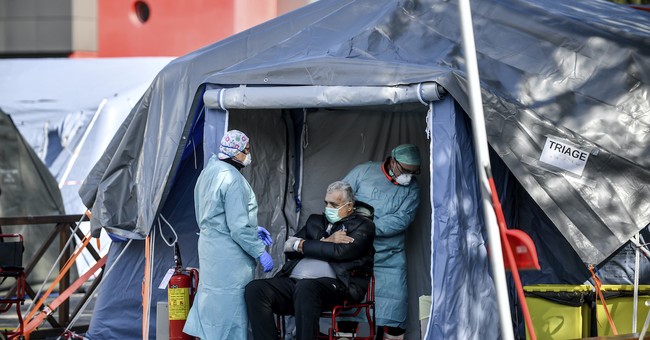 There’s been a debate about possible political motives surrounding the panic he has created; the massive economic damage he has inflicted; and the conflicting assertions of National Institute of Allergy and Infections Diseases (NIAID) Director Dr. Anthony Fauci.
There’s been a debate about possible political motives surrounding the panic he has created; the massive economic damage he has inflicted; and the conflicting assertions of National Institute of Allergy and Infections Diseases (NIAID) Director Dr. Anthony Fauci.CTH identifies the motives as sketchy. He appears to use his position to advance theories and yet position himself to avoid scrutiny.
Perhaps one way to help see through the professional obfuscation, and identify just exactly how political Dr. Fauci is, would be to: compare and contrast Dr. Fauci under President Obama in September 2009 after 3,000 to 4,000 H1N1 deaths in the USA -vs- Dr. Fauci under President Trump in March 2020 after 200 to 300 COVID-19 deaths. WATCH:
Now, to better absorb the information…. According to the CDC final estimate of 2009 U.S. H1N1 cases (published in 2011): from April 12, 2009 to April 10, 2010 approximately 60.8 million U.S. cases, 274,304 U.S. hospitalizations, and 12,469 U.S. deaths occurred due to H1N1. That’s the empirical data.
After: (1) watching that 2009 video; and (2) comparing the 2009 H1N1 response to the current 2020 COVID-19 response; and (3) reviewing the empirical data; we must admit to ourselves there is a VERY BIG difference. So now, with the baseline established, we look for why such a big difference; and to do that we (4) evaluate the politics:
A few months later:
Now, pause for a moment – reread that again – don’t skip past it. Think about what type of mindset would send such a letter and communication. Apply common sense. Trust your instincts…
Would a person of reasonable disposition send such a letter or email to anyone in their professional network? Would you ever consider writing a letter to your employer, or the family of your employer, declaring your undying love and devotion toward them?
“rarely does a speech bring me to tears”?… “please tell her I love her more than ever”?.. “please tell her that we all love her”… etc.
Seriously…. think about it. If you have ever engaged in a large system, large business, or large network of professionals, how would you react to a person inside that organization who was sending such non-professional communication? What exactly does that say about the emotional stability of such a person?
And this person, right now, with this inherent sensibility, has the most consequential and direct influence over the decision-making for the worlds most powerful nation. Stunning.
Now reconsider:
The concept of “flattening” the virus curve; the presumptive reason for social distancing and shutting down the U.S. economy; is based on a theory to extend the spread of COVID-19 to a lesser incident rate over a longer duration, thereby lessening the burden on the U.S. healthcare system. Hence, ‘flatten’ the spike in infections.
Put another way: “Flattening” means the same number of people eventually contract the virus, only they do so over a longer period of time, and the healthcare system can treat everyone because the numbers do not rise to level where the system is overloaded. In theory that seems to make sense.
However, no-one is asking: what is the current stress level on the healthcare system right now? Where are we in that capacity?… and what is normal capacity level during a high-level flu outbreak?… and Where are we when compared against that baseline?
♦ Remember in 2009 there were over 61 million cases of H1N1, more than 274,000 hospitalizations and 12,469 additional deathsspecifically attributed to that strain of flu virus in the U.S. [DATA HERE]
The premise to extend the virus duration in an effort to lower the infection rate and spread the virus over a longer period of time needs to measured against: (a) where the healthcare system is at any given moment; and (b) under traditional high-flu seasons where are we during those historic events.
♦ STRESS LEVEL – The healthcare ‘system’ per se, is expending an awful lot of time on mitigation efforts. As Dr. Birx noted: the current negative test rate for coronavirus among those showing symptoms who are tested is 94 to 98 percent. That means of all the people taking coronavirus tests, 94/98 out of 100 are symptomatic (they are sick) but they are not infected with coronavirus. They are normal flu cases.
Our healthcare “system” is expending an incredible amount of resources on a mitigation effort. According to Dr. Birx and the current U.S. test results, 94 to 98 percent of those mitigation efforts are not engaging with coronavirus. They are dealing with regular flu (perhaps a strong flu).
If you extract the mitigation effort from the overall effort, the current stress level on the healthcare system doesn’t seem to be overwhelming. What is stressing the system is a coronavirus mitigation effort with a rate of 94 to 98 percent testing negative.
If the viral spread never exceeds the capacity of the healthcare system to deal with it, he can claim success. Look, our flattened curve worked.
However, when contrast against flu outbreaks, no-one knows what the COVID-19 capacity threshold is within the healthcare system. There’s no way to disprove Fauci’s theory.
Given the nature of the baseline for overall U.S. sanitation and hygiene, which is significantly higher than Italy, S-Korea and China; and given the higher standards of food safety (U.S. is the world leader); again significantly higher than Italy, S-Korea and China; and given the nature of the U.S. healthcare system (more capacity per person); is it really a fair comparison to overlay a COVID-19 outbreak, without also overlaying a traditional flu outbreak?
Any theory that cannot be scientifically tested; and is simultaneously self-fulfilling; is, by its nature, a false theory.
This is not to say that Dr. Anthony Fauci is intentionally misleading anyone; however, it is absolutely true that no-one will be able to quantify if trillions of dollars of economic wealth lost; and trillions more in economic activity lost; and trillions more in deficit spending; and that might all be done just to follow the fantastical whims of a doctor who is directing the mitigation of an ordinary flu-virus/season, and appears to be quite full of his own sense of self-importance.
You decide….
I think I already have.













